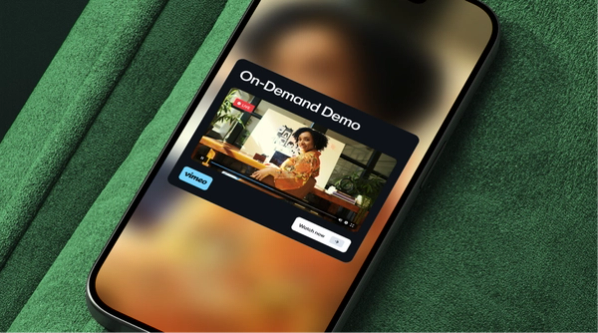
Over on LinkedIn, Superside’s Head of Video Strategy, Kirsten van Rooyen, highlights five pieces of trending video marketing news every single week. So, who better to ask about the video marketing trends to look out for in 2024? Get her take on the top trends you need to be aware of this year—the insights are free, the examples are priceless.
Marketers are great at capitalizing on trends.
Whether it’s a new viral trend on TikTok, a novel way to work with creatives, or even just a Google update, marketers are masters of the pivot. It’s a good thing, too, since staying relevant is so essential to creating videos that resonate with your target audience.
But everyone needs a little help, inspiration and fresh ideas sometimes. For video marketing, great timely content means separating the trends that have staying power from the fads.
So I spoke to Superside’s Head of Video Strategy, Kirsten van Rooyen, to sort fact from fad. Here are the top video marketing trends van Rooyen urges you not to ignore in 2024.
The Top 10 Video Marketing Trends in 2024
From embracing AI-powered video workflows to optimizing for sound preferences, keep these 10 video marketing trends top of mind as you develop, experiment and optimize your strategies this year.
1. Short-form video
I can’t even really call this one a trend—in 2024, it’s table stakes. When TikTok launched in 2016, few could have grasped the extent to which it would transform how we watch content. After it became the single most downloaded app across all platforms in 2022, every other big player rushed to create its own version of the TikTok experience. YouTube has Shorts, Instagram has Reels, and so on.
Marketers have already embraced this trend, exploring how short-form video allows for the delivery of branded or advertising content in a completely new format. But seeing as how these platforms are still experimenting with how to display ads, marketers should watch how short-form video evolves over the coming year.
Short-form started as a novelty. Then, it became the hot topic everyone was talking about. Now, you likely have customers who consume short-form video exclusively. So when you’re building your campaigns this year, think about the place short-form video should have in them. At Superside, we’ve seen success with short-form video across the funnel, from viral TikTok awareness plays to high-converting video ads.
Here’s one of our recent top-performing, short-form video ads (which also happens to tie in with the next trend!):
2. User-generated content (UGC) video
UGC has had an interesting trajectory over the past few decades. It’s gone from fueling the creation of dictionaries to giving brands easy content to share on their social media profiles and repurpose in advertising to becoming a completely distinct type of content creation.
Now, many brands are using user-generated content they’ve either sourced from different places on social media or actually commissioned from specialized content creators in their campaigns. Sometimes, it’s just part of a broader strategy. Other times, it’s the strategy.
UGC isn’t your typical social content: It’s lo-fi, low-budget and generated by average customers. Usually. More on that in just a sec...
Why is UGC going to be a trend to watch in 2024? Well, according to van Rooyen, there’s one solid reason: “Gen Z can sniff an ad on TikTok from a mile away.” And they’re probably not alone. How many times have you instantly scrolled past an ad on social media?
Brands are turning to UGC because it feels more authentic. It’s more like looking in a mirror than it is having an ad man shouting at you through a megaphone.
But in 2024, you can also create your own UGC-style ads, and they can be really successful. We should know; we generated 1,200 leads in one month with our own. Here it is:
3. Shoppable video
Live shopping and shoppable videos have been a big deal in places like China for a while, but this medium has started picking up steam in other places, too. TikTok Shop has been available in the U.S. for months now, and YouTube has given creators and advertisers the ability to create shoppable videos.
That means in 2024, you’ll have the keys to this new playground, allowing you to explore how brands can create awesome purchasing experiences for their audience with services and products they love.
Will you partner with content creators to turn them into ambassadors for your brand? Maybe you’ll create a campaign with shoppable videos that send your audience to a custom landing page and provide them with a completely new experience?
While it’s easy to dismiss shoppable videos as nothing more than the ability to add links to your online store, video marketers who want to get ahead in 2024 would be wise to seize this revenue-generating opportunity.
4. Interactive video
Video isn’t just a one-way channel anymore. Social media platforms, AR and other technologies have given audiences the ability to interact directly with the videos that come up in their feeds. But while these ideas have been around for a while, we’re likely to see them take a whole new angle in 2024.
It’s more like interactive video in a 3D space. It’s non-linear, so you’ll select which parts you want to interact with and click on hotspots. It ties really nicely into video shopping. So if content creators are wearing something beautiful, you can click on it, engage with it, and look at it from their point of view.

Where shoppable videos allow your audience to get to whatever you’re offering just a step away from your video content, interactive video will allow them to experience your entire brand from their devices.
5. AI-powered video production
2024 is the year for video and AI.

AI isn’t just a trend, it’s a revolution for creatives and marketers alike. When the hype first started in 2023, everyone scrambled to show off the latest amazing thing they did with ChatGPT, from poems recognizing their coworkers to creating entire companies run by AI-powered CEOs.
But moving past this craze, creatives and marketers are truly starting to explore AI’s potential.
AI can be a key part of your creative workflows—and it should be. It can help creatives go from initial ideas to pre-visualizations to a final product much faster. It can empower marketers to quickly cycle through ideas and explore divergent perspectives. But where most of that power was restricted to static images, copy and ideation last year, 2024 will be the year where video workflows benefit from the power of AI, too. Though, like with design and marketing, the need to have a creative mind at the helm won’t go away.
If something was shot too tightly, we’re able to open up the space and fill in the background with AI. We use tools that allow us to work with scripts and do a rough assembly of what they’ll look like. We can use AI voiceovers in pre-production until we’re ready to work with a human. It’ll just make systems and processes faster, but I don’t think it’ll ever replace video production.

6. SEO optimization of video
Marketers already know search engine optimization (SEO) is a powerful tool for driving results. Instead of putting all your budget into paid acquisition channels, you can create content that attracts organic traffic from search engines, bringing awareness to your brand and your campaigns by giving value to your target audience upfront.
But the SEO game is constantly changing.
Gen Z uses TikTok as a search engine more often than Google, and other generations have started getting used to alternative platforms, too. “YouTube is the original how-to-spot. Many a light in my life has been rewired via YouTube,” says van Rooyen.
And that’s why SEO will need to be a huge part of your video marketing strategy in 2024. Creating video content for online platforms won’t just be about getting your message across or your brand seen. If you want to drive long-term, sustained results, find out what your audience is searching for and get optimized video content in front of them—just like your content writers do.
7. Augmented reality (AR) and virtual reality (VR)
I think consumers are going to start being more open to AR and VR. As a result, brands are going to start to engage with it more. But it’s going to be a specialized part of your campaign, not the linchpin on which you’re driving your messaging.

When Mark Zuckerberg made the metaverse a huge focal point of Meta’s—at that point still called Facebook—Connect 2021 conference, he kicked off an obsession with virtual reality and augmented reality that had marketers scrambling to capitalize on this trend.
But now, three years later, where do AR and VR sit in the video marketing world?
Though adoption has been slow in the marketing space overall, 2024 may be the year we see these technologies pick up steam. With the advent of AI and the ease with which companies can put out content, everyone’s feeds will be more flooded than ever. As a result, marketers will need to shift towards mediums that allow them to connect more deeply with their audiences—and AR and VR fit the bill.
For instance, marketers who integrate AR into their video advertising have already seen three times the brand lift than business-as-usual (BAU) campaigns alone. So, those who boldly adopt this medium may find the returns are well worth it in 2024.
8. 360-degree video
360-degree video, especially when combined with AR and VR, can be an incredibly powerful asset for certain campaigns. Real estate agents, for example, are already running with this format. As a marketer going into 2024, think about how you can use these types of videos the same way realtors do; to give your audience an experience that’s just not possible with more static formats.
Whether it’s through a VR headset or a feature like YouTube 360 there’s a subset of your audience that won’t just appreciate this kind of video; they’ll come to expect it.
You may think 360-degree video makes the most sense for B2C brands, but finding unexpected, delightful ways to engage your audience can be the territory of B2B brands, too. As we’ve all heard at this point, business to business doesn’t have to mean boring to boring!
Here’s an example of a 360-degree video from Google’s Arts & Culture project:
9. Sound on vs. sound off
There was a time when you could expect your audience to hear at least a few seconds of your marketing video’s audio, but in 2024 you won’t be able to make that assumption anymore. Formats like short-form video have made it much more common for audiences to engage with content with the sound off, which means concepts that rely heavily on audio might not perform as well as they used to.
But that doesn’t mean all your video content shouldn’t have any sound.
The classic line is true: Inform with sound off and delight with sound on. I don’t think there’s going to be as major a shift as other trend predictors are saying, that sound off is going to be everything.

You can make some simple changes to account for this new landscape—like including captions in most, if not all of your video content. And this isn’t just a great way to recognize this trend, but it helps set a new standard for accessibility. Always think about both accessibility and your audience’s preferences when you’re creating video.
With this in mind, all our social videos here at Superside get bold caption treatments:
10. Connected TV (CTV) and over-the-top (OTT) platforms
About 60 million American households pay for television, which sounds like a big number until you realize it’s down 40% from just a decade ago. This demonstrates something most marketers already know; advertising on television isn’t the powerhouse it used to be.
Many households now use streaming services exclusively to get their entertainment and news, subscribing to over-the-top (OTT) services (like YouTube TV and Hulu) and connected TV (CTV) devices. These can be anything from Google’s Chromecast and Fire Sticks to smart TVs and even just a smartphone itself.
What does this mean for marketers?
A few things, actually:
- Your target audience will be in a different mindset then when they view a social ad. Whether it’s because they’re enjoying their content in a more relaxed setting or they’re watching something completely unrelated to work, the mindset of your audience will be something to think about when you experiment with this type of video advertising.
- Analytics can be incredibly powerful. While marketers have had to get used to the dwindling power of their analytics with other channels, many CTV platforms provide in-depth tracking metrics like completion rates, engagement and conversion.
- Formats and strategy will be different. Content streamed through CTVs is often watched on larger screens and in more relaxed environments than what’s consumed on smartphones and desktops. You’ll want to prioritize ads that use sound, land the brand and have a powerful CTA.
CTV advertising should be integrated with broader marketing campaigns. Consistency across channels—like social media web, and mobile—ensures your brand message stays cohesive while amplifying the overall impact of your marketing strategy.

Make Video Marketing a Top Performer in 2024
AI-powered workflows, new platforms, new formats, the list goes on. Marketers need to keep their eye on these video marketing trends to stay ahead of the game and keep their campaigns relevant in 2024.
Need a little help with your video game?
With Superside in your corner, you can spin up video marketing campaigns in a fraction of the time while relying on experts, like van Rooyen, who are already on top of the latest trends. Interested? Let’s talk!


















